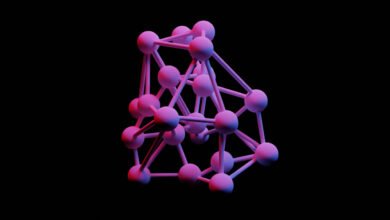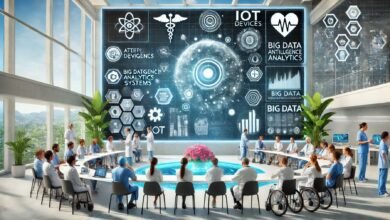How IoT Is Transforming Healthcare Systems in Germany
This article delves into how IoT is revolutionizing the German healthcare ecosystem, highlighting key technologies, use cases, benefits, challenges, and future prospects.

The integration of the Internet of Things (IoT) in the healthcare sector is reshaping the way medical services are delivered, particularly in technologically advanced nations like Germany. IoT is transforming healthcare systems by enabling seamless data sharing, real-time monitoring, and improved patient outcomes. With Germany’s aging population and growing demand for efficient healthcare, IoT-based solutions are not only timely but crucial. This article delves into how IoT is revolutionizing the German healthcare ecosystem, highlighting key technologies, use cases, benefits, challenges, and future prospects.
Understanding IoT in Healthcare
The Internet of Things (IoT) refers to interconnected devices and systems that collect and exchange data via the internet. In healthcare, IoT encompasses wearables, remote monitoring tools, smart hospital infrastructure, and AI-driven diagnostics. These devices gather health metrics in real time, enabling better diagnosis, personalized treatments, and proactive care.
Germany’s Healthcare Landscape: A Fertile Ground for IoT
Germany boasts one of the most robust healthcare systems globally, characterized by a strong public health infrastructure and a thriving private sector. However, the system faces challenges such as rising healthcare costs, staff shortages, and the need for elderly care. These factors create an ideal environment for IoT to make a significant impact.
Government initiatives like the “Digital Healthcare Act” (Digitale-Versorgung-Gesetz) and increasing investment in telemedicine further support the integration of digital technologies in healthcare.
Key Applications of IoT in German Healthcare
- Remote Patient Monitoring (RPM) Remote patient monitoring is one of the most impactful ways IoT is transforming healthcare systems. In Germany, patients with chronic conditions like diabetes and heart disease are using wearable devices to monitor vital signs such as blood glucose, heart rate, and oxygen levels. These devices send real-time data to healthcare providers, allowing for timely interventions and reduced hospital visits.
- Smart Hospitals and Infrastructure IoT enables the development of smart hospitals equipped with interconnected devices that monitor everything from patient movements to energy consumption. In Germany, hospitals are increasingly adopting smart beds, RFID-tagged equipment, and automated inventory management systems. This not only improves operational efficiency but also enhances patient safety.
- Medication management IoT-based pill dispensers and medication tracking systems are helping German patients adhere to their treatment regimens. These systems send reminders, track dosage intake, and notify healthcare providers in case of discrepancies, thereby reducing the risk of medication errors.
- Emergency Response and Ambulance Services IoT devices installed in ambulances provide real-time patient data to hospital emergency rooms, allowing them to prepare in advance. In Germany, connected ambulances are equipped with telehealth capabilities, enabling remote consultations during transit.
- Elderly Care and Assisted Living With a growing elderly population, Germany is leveraging IoT for senior care. Smart home devices, fall detectors, and wearable emergency buttons help caregivers monitor elderly patients remotely, ensuring timely assistance and greater independence.
- Predictive Analytics and AI Integration IoT systems integrated with artificial intelligence analyze large datasets to predict health issues before they become critical. In German hospitals, predictive analytics is being used to identify at-risk patients, optimize resource allocation, and reduce readmission rates.
Benefits of IoT in the German Healthcare System
- Improved Patient Outcomes: Continuous monitoring and real-time alerts help in early diagnosis and better treatment.
- Operational Efficiency: Automation and data-driven decisions streamline hospital operations.
- Cost Reduction: By minimizing hospital stays and avoiding emergency interventions, IoT reduces overall healthcare costs.
- Enhanced Patient Engagement: Patients become active participants in their healthcare through access to real-time data and personalized health insights.
- Data-Driven Decision Making: IoT provides healthcare professionals with comprehensive data for accurate diagnoses and effective treatments.
Challenges and Limitations
Despite its many advantages, the adoption of IoT in healthcare is not without challenges:
- Data Security and Privacy: Ensuring the confidentiality and integrity of patient data is a significant concern, especially under Germany’s strict GDPR regulations.
- Interoperability Issues: Integrating various IoT devices and legacy systems can be complex.
- High Initial Costs: The upfront investment in IoT infrastructure can be a barrier for smaller healthcare facilities.
- Technological Literacy: Both healthcare providers and patients require training to effectively use IoT technologies.
Government Support and Regulations
Germany has been proactive in fostering a digital healthcare environment. The Digital Healthcare Act mandates the integration of digital health apps into statutory health insurance, thereby promoting IoT usage. The country also supports initiatives like the “eHealth Strategy” and “Health Innovation Hub” to explore innovative digital solutions. Compliance with GDPR ensures that patient data remains secure, further encouraging adoption.
Real-World Examples and Case Studies
- Charité – Universitätsmedizin Berlin: One of Europe’s largest university hospitals, Charité, has implemented IoT-based remote monitoring systems to track post-operative patients, resulting in lower readmission rates.
- Siemens Healthineers: A global leader headquartered in Germany, Siemens Healthineers offers a wide array of IoT-powered diagnostic and imaging tools used across German hospitals.
- TeleClinic: A telemedicine platform approved by German health authorities, TeleClinic integrates IoT devices for virtual consultations and digital prescriptions.
Future Outlook: What Lies Ahead
The future of IoT in German healthcare looks promising. With advancements in 5G connectivity, edge computing, and AI, the capabilities of IoT will expand further. Future trends may include:
- Digital Twins: Creating virtual replicas of patients for personalized simulations and treatment planning.
- Blockchain Integration: For secure and transparent health data management.
- Advanced Robotics: IoT-connected surgical robots to assist in precision surgeries.
- Expanded Home Healthcare: Enhanced smart home integration for long-term patient monitoring.
Conclusion
IoT is transforming healthcare systems in Germany by making them more efficient, responsive, and patient-centric. From smart hospitals and remote monitoring to AI-driven analytics and emergency response, the applications are vast and growing. While challenges remain, the benefits far outweigh the hurdles, especially with strong government support and ongoing technological advancements. As Germany continues to innovate, the role of IoT in healthcare will only become more central, ultimately leading to a healthier, more connected society.











